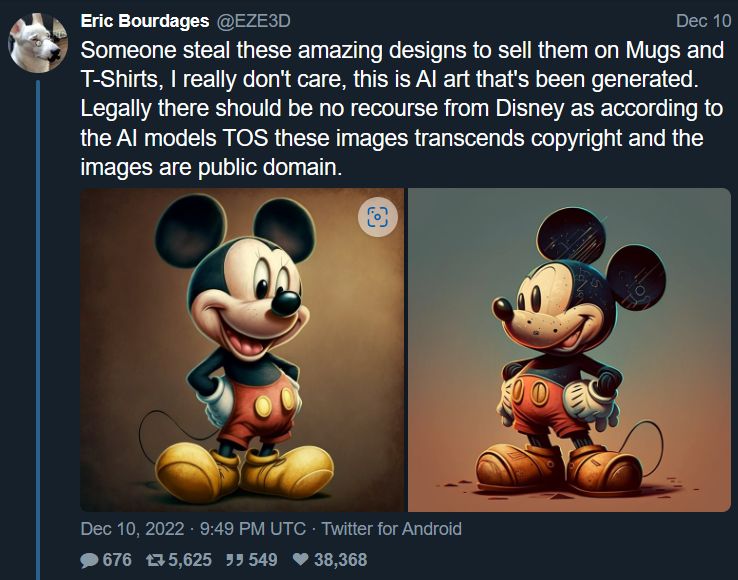Artists are forcing Disney to address their growing AI problem

In Brief
Artists see no end to AI taking over jobs – they’re using “Mickey Mouse” strategy
As the trend of AI taking over people’s jobs continues, the latest group to take action are artists who feel they may be viewed as obsolete. They’re using artificial intelligence systems to create images of copyrighted characters, including Disney’s Mickey Mouse. Given Disney’s history of heavily protecting its content, the artists are hoping that the company will take action and thereby put pressure on AI, giving people their jobs back.

The artists say they’re not trying to destroy Disney but simply want it to address the growing problem of AI. The artists say they hope to spark a larger conversation about the role of AI in the creative industries.
“The artists have always been very resistant to change, but I think they’re finally starting to realize that they need to adapt or they’re going to become irrelevant.”
said one artist who spoke on the condition of anonymity.
“If you don’t start to address the issue, eventually, there won’t be any jobs for humans,” said another artist. “And that includes jobs at Disney.”
Over the weekend, Eric Bourdage, lead character artist on the popular video game Dead by Daylight, encouraged his followers to create and sell products using images of Disney characters.

“The obvious issue that I’m opposing in my thread is the theft of human art. Skill, time, people’s efforts and ideas are taken without their consent and used to create a product which can combine all of this and mimic to varying degrees.”
Eric Bourdage explains.
AI art problem continues to spark mass protests and resistance from the art community
The digital art community is up in arms over the inclusion of AI-generated content on ArtStation. Artists have long used ArtStation as a platform to showcase their work and receive feedback from the community. However, the recent inclusion of AI-generated content has been a controversial issue. Some artists claim that such content devalues the work of human creators.
This debate came to a head in recent months when a number of artists demanded that ArtStation remove AI-generated content from its website. The movement gained traction, and ArtStation eventually agreed to remove the content in question.
However, the issue is far from resolved. Some artists believe that AI-generated content has a place on ArtStation and that removing it would be a step backward. Others believe that AI-generated content should be clearly labeled as such so that viewers can make an informed decision about whether or not to view it.
The debate is likely to continue for some time. In the meantime, ArtStation has made it clear that it is willing to listen to the concerns of the digital art community and make changes accordingly.
Read more about AI:
Disclaimer
In line with the Trust Project guidelines, please note that the information provided on this page is not intended to be and should not be interpreted as legal, tax, investment, financial, or any other form of advice. It is important to only invest what you can afford to lose and to seek independent financial advice if you have any doubts. For further information, we suggest referring to the terms and conditions as well as the help and support pages provided by the issuer or advertiser. MetaversePost is committed to accurate, unbiased reporting, but market conditions are subject to change without notice.
About The Author
Damir is the team leader, product manager, and editor at Metaverse Post, covering topics such as AI/ML, AGI, LLMs, Metaverse, and Web3-related fields. His articles attract a massive audience of over a million users every month. He appears to be an expert with 10 years of experience in SEO and digital marketing. Damir has been mentioned in Mashable, Wired, Cointelegraph, The New Yorker, Inside.com, Entrepreneur, BeInCrypto, and other publications. He travels between the UAE, Turkey, Russia, and the CIS as a digital nomad. Damir earned a bachelor's degree in physics, which he believes has given him the critical thinking skills needed to be successful in the ever-changing landscape of the internet.
More articles

Damir is the team leader, product manager, and editor at Metaverse Post, covering topics such as AI/ML, AGI, LLMs, Metaverse, and Web3-related fields. His articles attract a massive audience of over a million users every month. He appears to be an expert with 10 years of experience in SEO and digital marketing. Damir has been mentioned in Mashable, Wired, Cointelegraph, The New Yorker, Inside.com, Entrepreneur, BeInCrypto, and other publications. He travels between the UAE, Turkey, Russia, and the CIS as a digital nomad. Damir earned a bachelor's degree in physics, which he believes has given him the critical thinking skills needed to be successful in the ever-changing landscape of the internet.






















































